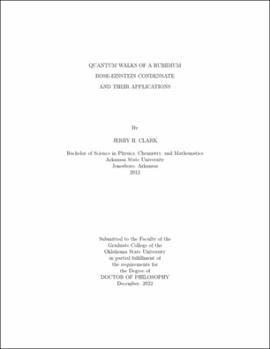| dc.contributor.advisor | Liu, Yingmei | |
| dc.contributor.author | Clark, Jerry H. | |
| dc.date.accessioned | 2023-07-05T20:56:55Z | |
| dc.date.available | 2023-07-05T20:56:55Z | |
| dc.date.issued | 2022-12 | |
| dc.identifier.uri | https://hdl.handle.net/11244/337890 | |
| dc.description.abstract | A quantum walk in momentum space with a rubidium spinor Bose-Einstein condensate was recently realized in our research group by applying a periodic kicking potential as a walk operator and a resonant microwave pulse as a coin toss operator. The generated quantum walks appear to be stable for up to ten steps and then quickly transit to classical walks due to spontaneous emissions induced by laser beams of the walk operator. The quantum to classical walk transitions were investigated by introducing well-controlled spontaneous emissions with an external light source during quantum walks. Our findings demonstrate a scheme to control the robustness of the quantum walks and can also be applied to other cold atom experiments involving spontaneous emissions. Our QW possessed behaviors that generally agreed with theoretical predictions; however, it also showed momentum distributions that were not adequately explained by the theory. A theoretical model is presented in which the coherent dynamics of the spinor condensate is sufficient to explain the experimental data without invoking the presence of a thermal cloud of atoms as in the original theory. These numerical findings are supported by an analytical prediction for the momentum distributions in the limit of zero-temperature condensates. This current model provides more complete explanations to the momentum-space QWs that can be applied to study quantum search algorithms and topological phases in Floquet-driven systems. Finally, a concrete theoretical proposal for detecting topological phase transitions in double kicked atom-optics kicked rotors with internal spin-1/2 degree of freedom is presented. Its implementation utilizes a kicked Bose-Einstein condensate evolving in one-dimensional momentum space. To reduce the influence of atom loss and phase decoherence, possible techniques to keep experimental durations short while maintaining a resonant experimental protocol are presented. Experimental limitations induced by phase noise, quasimomentum distributions, symmetries, and the ac-Stark shift are considered. These results thus suggest a feasible and optimized procedure for observing topological phase transitions in quantum kicked rotors. | |
| dc.format | application/pdf | |
| dc.language | en_US | |
| dc.rights | Copyright is held by the author who has granted the Oklahoma State University Library the non-exclusive right to share this material in its institutional repository. Contact Digital Library Services at lib-dls@okstate.edu or 405-744-9161 for the permission policy on the use, reproduction or distribution of this material. | |
| dc.title | Quantum walks of a rubidium Bose-Einstein condensate and their applications | |
| dc.contributor.committeeMember | Rosenberger, Albert T | |
| dc.contributor.committeeMember | Meyers, Derek | |
| dc.contributor.committeeMember | Binegar, Birne | |
| osu.filename | clark_okstate_0664d_17969.pdf | |
| osu.accesstype | Open Access | |
| dc.type.genre | Dissertation | |
| dc.type.material | Text | |
| thesis.degree.discipline | Physics | |
| thesis.degree.grantor | Oklahoma State University | |
